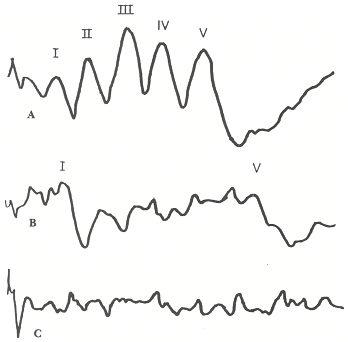The Auditory Brainstem Response (ABR) test is an electrophysiological measurement that allows audiologists to predict hearing sensitivity based on responses (evoked potentials) from the central auditory nervous system. The ABR involves the recording of microvolt electrical activity from surface electrodes in a quiet environment while a patient is sleeping. ABR is a critical part of the pediatric audiologic battery because it provides an accurate and reliable prediction of hearing loss in children too young or developmentally unable to fully participate in behavioral testing. Utilizing air-conducted, bone-conducted, and frequency-specific stimuli, the ABR test produces information on degree, type and configuration of hearing loss and this information can be used to fit a patient with hearing aids.
As in behavioral audiometry, bone conduction ABR uses a bone conduction transducer to deliver vibrations directly to the inner ear, bypassing the outer and middle ear structures. Comparison of bone conduction and air conduction ABR results can be used to distinguish between sensorineural and conductive hearing loss.
ABRs are conducted using either frequency-specific or click stimuli. Threshold information is recorded at 500, 1000, 2000, and 4000 Hz and there is a good agreement (+/- 10-15Hz) between frequency specific ABR and behavioral audiograms in infants and young children. Click stimuli evoke responses in the frequency range from 100-8000 Hz, which is too broad to estimate hearing sensitivity. Click stimuli presented at high levels (80-90 dB nHL) are used to distinguish between cochlear and neural dysfunction.
Waveforms: Each ABR generates a waveform. Waves I and II result from the eighth nerve while later waves reflect postsynaptic activity in major brainstem auditory centers. Wave V, the component most analyzed in clinical applications, originates from the inferior colliculus. The image on the right shows an ABR waveform.

